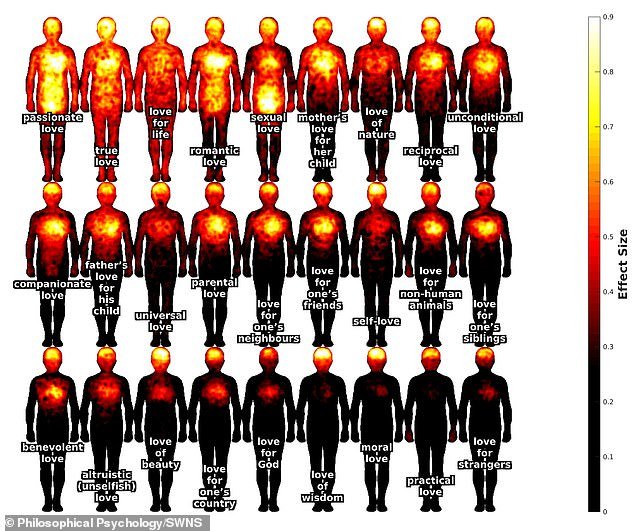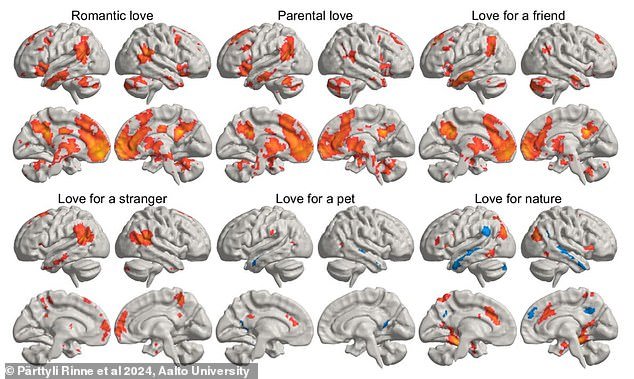While heaps of mushroom poetry, plays and love songs may beg to differ, scientists are always keen to point out that love is felt not in the heart – but in the brain.
Now, thanks to a new study from researchers at Aalto University in Finland, romantically inclined scientists can be even more precise.
From the romantic love for your partner to the love you feel for your dog, incredible maps reveal which areas of the brain are activated by different types of love.
While romantic love is strongly felt in the social areas of the brain, a parent’s love for their children produced the most powerful response of all.
Dr. Pärttyli Rinne, a philosopher and researcher who led the study, says: ‘In parental love, there was activation deep in the brain’s reward system in the striatum area while imagining love, and this was not seen for any other kind of love.’
Scientists have mapped the activation of the brain while it experiences love to reveal exactly how different types of love are felt. Pictured: The areas of the brain most often associated with interpersonal love
To see exactly where love was felt in the brain, the researchers recruited 55 parents who self-described as being in a loving relationship.
While in an fMRI machine, these participants were read a series of short stories, each describing a different type of love.
For example, to elicit a sense of parental love, participants were read: ‘You are seeing your newborn child for the first time. The baby is soft, healthy and hearty – the greatest wonder of your life. You feel love for the little one.’
To provide a baseline measurement for comparison, participants were also given a few unusually boring neutral scenarios, such as looking out the bus window.

55 participants were placed in an fMRI scanner while they were read stories describing different types of love. Pictured, the brain when it experiences romantic love

Researchers found that most interpersonal forms of love activate the same areas to varying degrees, but the most intense of all was parental love

Parental love activates areas deep in the brain’s reward system, something not seen in any other form of love (file image)
The participants were then allowed to sit for 10 seconds to imagine themselves in the scenario while the researchers took careful recordings of their brain states.
By combining the results from each of the participants, the researchers were able to create a map for six different types of love.
Dr. Rinne has previously mapped where in the body different forms of love are felt, but this gives the first insight into the neurological processes behind the experience.
Most types of love involving humans were found to activate similar areas in the social regions of the brain.
Dr. Rinne says: ‘The activation pattern of love is generated in social situations in the basal ganglia, the midline of the forehead, the precuneus and the temporoparietal junction on the sides of the back of the head.’
The biggest difference between types of love was the intensity of the brain activation they triggered.

Romantic love, as well as other interpersonal forms of love, tends to be felt in the basal ganglia, the midline of the forehead, and on the back and sides of the head. Pictured: Crazy Stupid Love

The better we know someone, the greater the activation in the areas of the brain associated with social activity. Pictured: brain activation associated with love for a friend

Compared to the love of a friend, the love we feel for strangers (pictured) produces relatively little brain activation
For example, compare the brain map associated with the love you feel for a stranger with the one associated with love for a friend.
The closer someone is to us, the more intensely the social areas of our brains are activated in response to that feeling of love.
The most powerful activation of all was the love experienced by a parent for a child, followed by romantic.
However, the pattern of brain activation was not only influenced by proximity to the object of our love, but also by the type of object.
Love of pets and love of nature produce distinctly different patterns of activation than those produced by love of other people.
For example, the love of nature activates the reward center regions associated with visual processing and spatial awareness.

The type of brain activation observed also varied depending on the type of thing loved. The love of pets (pictured) produces very different activation patterns than another person’s

The love of nature activated areas of the brain associated with spatial awareness and visual processing (pictured)
The only exception was found in participants who were also pet owners.
The researchers found that living with your furry friend made such significant changes to your thought processes that they could spot the pet owners by their brain activity.
The participants were read a sentence such as: ‘You are at home lounging on the sofa and your cat lies down next to you. The cat curls up next to you and purrs sleepily. You love your pet.’
For pet owners, and no one else, hearing this story also activates the social areas of the brain more typically associated with love for people.

The researchers have previously mapped where in the body different forms of love were felt by asking where the participants tended to feel the experience the most

The researchers found that participants who had their own pets experienced brain activation in the social areas of the brain when they pictured a scenario involving their pets
This supports a growing body of evidence that human love for our pets can indeed transcend species boundaries.
Recent research has found that when humans look into their pets’ eyes, it activates oxytocin pathways similar to mother-infant bonding.
Dr. Rinne says: ‘When looking at pet love and the brain activity associated with it, brain areas associated with sociality statistically reveal whether the person is a pet owner or not.
‘When it comes to pet owners, these areas are more activated than in non-pet owners.
